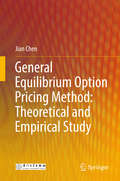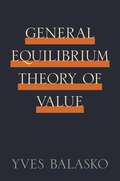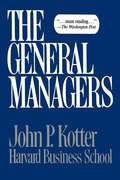- Table View
- List View
General Electric vs. Westinghouse in Large Turbine Generators (C)
by Michael E. PorterSupplements the (A) case.
General Electric: Jack Welch's Second Wave (A)
by Christopher A. Bartlett Kenton W. ElderkinBy the mid 1980's Jack Welch had completely transformed General Electric with more than 300 divestitures and acquisitions since the beginning of the decade. Welch insisted that his business units be number one or number two in their markets, and have the strength of large companies and the leanness and agility of small ones. Yet, although Welch had succeeded restructuring GE the way he wanted, employee morale was low. The case focuses on Welch raising employee productivity by continuing to remove layers of management and by allowing employees to have a greater voice in their own affairs.
General Electric: Reg Jones and Jack Welch
by Christopher A. Bartlett Kenton W. Elderkin Francis J. AguilarWhen GE's retiring Reginald Jones turned the job of CEO over to Jack Welch on April 1, 1981, the Wall Street Journal reported that GE had "decided to replace a legend with a live wire." Some wondered if the young dynamo could fill the elder statesman's very large shoes. But Welch had a very powerful and well-articulated vision of where he wanted his company to go. By 1984, he had regrouped GE's sectors, redefined its core businesses, made massive investment and disinvestment decisions, changed the company's approach to planning, and drastically cut personnel. Despite a major recession in the world economy and flat sales, profits rose from $1.5 billion in 1980 to $2.3 billion in 1984. This case chronicles the evolution of GE through the 1970s and early 1980s, focusing particularly on the changes wrought by Reg Jones and the way in which Jack Welch took that heritage and reshaped it to fit the demands of a new decade.
General Electric: Strategic Position--1981
by Richard G. Hamermesh Francis J. AguilarDescribes the introduction and evolution of General Electric's strategic planning system from the 1960s to Jack Welch's tenure. Allows discussion of the interplay of problems and circumstances to the evolution of the strategic planning system, and how Welch might use or alter the system to meet the challenge of growth.
General Electric: Strategic Position--1981
by Richard G. Hamermesh Francis J. AguilarDescribes the introduction and evolution of General Electric's strategic planning system from the 1960s to Jack Welch's tenure. Allows discussion of the interplay of problems and circumstances to the evolution of the strategic planning system, and how Welch might use or alter the system to meet the challenge of growth.
General Equilibrium Analysis: A Century after Walras (Routledge Studies In The History Of Economics Ser. #131)
by Pascal Bridel2010 marks the hundredth anniversary of the death of Léon Walras, the brilliant originator and first formaliser of general equilibrium theory – one of the pillars of modern economic theory. In advancing much derided practical solutions Walras also displayed more concern for the problems of living in a second best world than is common in modern pure theories of the invisible hand, efficient market hypothesis, DSGE macroeconomics or the thinking of some contemporary free market admirers all based on general equilibrium theory. This book brings contributions from the likes of Kenneth Arrow, Alan Kirman, Richard Posner, Amartya Sen and Robert Solow to share their thoughts and reflections on the theoretical heritage of Léon Walras. Some authors reminisce on the part they played in the development of modern general economics theory; others reflect on the crucial part played by general equilibrium in the development of macroeconomics, microeconomics, growth theory, welfare economics and the theory of justice; others still complain about the wrong path economic theory took under the influence of post 1945 developments in general equilibrium theory.
General Equilibrium Analysis: A Micro-Economic Text
by Harry G. JohnsonThis is a new kind of textbook in microeconomic theory. In place of the usual concentration on partial equilibrium analysis and discussion of a standard series of topics, the authors seek to introduce the student from the start to the general equilibrium approach to microeconomics, in the form of the two-sector model. This model is then applied to a variety of subjects in different special fields of economic analysis: welfare economics, international trade, public finance and income distribution. This book represents a very different approach to the teaching of micro-economic theory than normally followed, and one that will be of greater long-run value to the serious student of economics. In place of the usual textbook development of the subject as traditionally conceived through topics of increasing complexity and analytical difficulty, using partial equilibrium techniques of analysis, the book concentrates on the exposition and application of a more logically integrated set of tools that have been found of greater use in the analysis of problems arising not only in traditional micro-economics but also in a number of fields of economics that have customarily been hived off into separate specialized advanced courses. General Equilibrium Analysis starts with the description of the two-sector model and how these two sectors are built based on the individual micro-units in which they made up of and how they fit into the concept of the circular flow of income. Subsequent chapters deal with the evaluation of changes in factor endowment, demand preferences and technical progress by means of the model; and the theory of government, which includes both the theory of government expenditure, or public goods, and the theory of government tax and/or subsidy programmes-changes in budgetary scale, tax substitution and expenditure substitution. The model is then extended to an open economy-the so-called "two by two by two"--to consider both the normative effect of inte
General Equilibrium Option Pricing Method: Theoretical and Empirical Study
by Jian ChenThis book mainly addresses the general equilibrium asset pricing method in two aspects: option pricing and variance risk premium. First, volatility smile and smirk is the famous puzzle in option pricing. Different from no arbitrage method, this book applies the general equilibrium approach in explaining the puzzle. In the presence of jump, investors impose more weights on the jump risk than the volatility risk, and as a result, investors require more jump risk premium which generates a pronounced volatility smirk. Second, based on the general equilibrium framework, this book proposes variance risk premium and empirically tests its predictive power for international stock market returns.
General Equilibrium Theory of Value
by Yves BalaskoThe concept of general equilibrium, one of the central components of economic theory, explains the behavior of supply, demand, and prices by showing that supply and demand exist in balance through pricing mechanisms. The mathematical tools and properties for this theory have developed over time to accommodate and incorporate developments in economic theory, from multiple markets and economic agents to theories of production. Yves Balasko offers an extensive, up-to-date look at the standard theory of general equilibrium, to which he has been a major contributor. This book explains how the equilibrium manifold approach can be usefully applied to the general equilibrium model, from basic consumer theory and exchange economies to models with private ownership of production. Balasko examines properties of the standard general equilibrium model that are beyond traditional existence and optimality. He applies the theory of smooth manifolds and mappings to the multiplicity of equilibrium solutions and related discontinuities of market prices. The economic concepts and differential topology methods presented in this book are accessible, clear, and relevant, and no prior knowledge of economic theory is necessary. General Equilibrium Theory of Value offers a comprehensive foundation for the most current models of economic theory and is ideally suited for graduate economics students, advanced undergraduates in mathematics, and researchers in the field.
General Equilibrium, Overlapping Generations Models, and Optimal Growth Theory
by Truman F. BewleyThis book presents an original exposition of general equilibrium theory for advanced undergraduate and graduate-level students of economics. It contains detailed discussions of economic efficiency, competitive equilibrium, the first and second welfare theorems, the Kuhn-Tucker approach to general equilibrium, the Arrow-Debreu model, and rational expectations equilibrium and the permanent income hypothesis. Truman Bewley also treats optimal growth and overlapping generations models as special cases of the general equilibrium model. He uses the model and the first and second welfare theorems to explain the main ideas of insurance, capital theory, growth theory, and social security. It enables him to present a unified approach to portions of macro- as well as microeconomic theory. The book contains problems sets for most chapters.
General Equilibrium: Problems and Prospects (Routledge Siena Studies in Political Economy)
by Fabio Pertri Frank HahnIn recent years certain leading figures in the world of economics have called the usefulness of general equilibrium theory into question. This superb new book brings together leading economic theorists with important contributions to the ongoing debate.General equilibrium theorists including Michio Morishima, Michael Magill and Martine Quinzii debate strengths, weaknesses and possible futures with leading thinkers such as Herb Gintis, Pierangelo Garegnani and Duncan Foley, who seek to explain the rejection of general equilibrium. Uniquely, none of the contributors portray general equilibrium theory as the perfect guide to market economies actual behaviour, but rather illustrate that there is insufficient acquaintance with existing alternatives and that general equilibrium theory is often used as an ideal 'benchmark'.
General Growth Properties and Pershing Square Capital Management
by Arthur I Segel Stuart C. Gilson Thomas Langer Zubin Malkani John MascariCase
General Interests of Host States in International Investment Law
by Giorgio Sacerdoti Pia Acconci Mara Valenti Anna De Luca Giorgio Sacerdoti Pia Acconci Mara ValentiSignatory States have the right to take action in order to maintain their financial stability, stimulate economic development or further their non-economic interests (such as health, the environment and food security). However, such measures can potentially conflict with the rights of foreign investors. Regulators and policy makers must take States' international commitments toward foreign investors into account when making decisions. They must also avoid resorting to protectionism in drafting new treaties. With this tension in mind, this book offers a balanced reappraisal of bilateral treaties and regional agreements on foreign investments. The sensitive issues are examined in the light of the case law of arbitral investment tribunals and other international courts, and the analysis highlights how cross-fertilisation between trade and investment can assist in resolving conflicts.
General Management in Latin and Ibero-American Organizations: A Humanistic Perspective
by Joan E. Ricart Adrián A. Caldart Alejandro A. CarreraThis book provides an examination of the general manager, which encompasses their roles as strategist, organizational designer and institutional leader. Instead of exclusively focusing on the economic aspect of general management, this book explores a humanist perspective based on the conviction that maintaining high ethical standards is a precondition to the healthy, long-term prosperity of firms and, more importantly, the development of employees. Bringing together a team of contributors from several prestigious business schools in Spain, Portugal, and Central and South America, this book develops the field of general management through academic thinking, research and practical experience in the form of original and relevant case studies from the perspective of Ibero-American business communities. After explaining the foundations of its call for humanist general management practices, the authors focus on themes inherent to strategy and organizing such as sustainability, business model innovation, strategy in emerging markets, strategic alliances, digital strategy and organizational learning. They conclude by focusing on institutional leadership, and provide a fresh look at boards of directors, risk management, family businesses, stakeholder management and the work of CEOs. General Management in Latin and Ibero-American Organizations is an invaluable resource that will be of great interest to practitioners and students in the field of international business, management, organization studies, strategy in emerging markets, leadership and corporate governance.
General Managers
by John P. KotterIn this unprecedented study of America's leading executives, John Kotter shatters the popular management notion of the effective "generalist" manager who can step into any business or division and run it. Based on his first-hand observations of fifteen top GMs from nine major companies, Kotter persuasively shows that the best manager is actually a specialist who has spent most of his or her career in one industry, learning its intricacies and establishing cooperative working relationships. Acquiring the painstaking knowledge and large, informal networks vital to being a successful manager takes years; outsiders, no matter how talented or well-trained seldom can do as well, this in-depth profile reveals. Much more than a fascinating collective portrait of the day-to-day activities of today's top executives, The General Managers provides stimulating new insights into the nature of modern management and the tactics of its most accomplished practitioners.
General Mills Board and Strategic Planning
by Jay W. Lorsch James E. SailerExamines the General Mills Board of Directors' role in the General Mills joint venture with Nestle S.A. to sell cereals outside of North America. It raises the more general question of the appropriate role for the board of directors in strategy formulation.
General Mills, Inc.: Yoplait Custard-Style Yogurt (A)
by John A. Quelch John L. TeopacoYoplait's director of new product development is evaluating alternative line extensions including custard-style Yoplait. He must determine what additional research to recommend. Options include a mini-market test, a simulated test market and a fully-fledged test market.
General Mills: Responding to the Killing of George Floyd (A)
by Debora L. Spar Alicia DadlaniJeff Harmening, CEO of General Mills, one of the world's largest manufacturers of breakfast cereals and packaged foods, was deeply disturbed and instantly aware that he and General Mills would need to respond. George Floyd, an African-American man who had been accused by a sales clerk of using a counterfeit $20 bill to buy cigarettes, had been arrested and then killed by Minneapolis police. The video of his heart-wrenching death had gone viral worldwide. In the past, the company had not typically commented on racial incidents. But this time felt different. As the leader of one of Minneapolis' largest companies, and one profoundly committed to its community, Harmening needed to determine how and to whom to respond.
General Mills: Responding to the Killing of George Floyd (B)
by Debora L. Spar Alicia DadlaniJeff Harmening, CEO of General Mills, one of the world's largest manufacturers of breakfast cereals and packaged foods, was deeply disturbed and instantly aware that he and General Mills would need to respond. George Floyd, an African-American man who had been accused by a sales clerk of using a counterfeit $20 bill to buy cigarettes, had been arrested and then killed by Minneapolis police. The video of his heart-wrenching death had gone viral worldwide. In the past, the company had not typically commented on racial incidents. But this time felt different. As the leader of one of Minneapolis' largest companies, and one profoundly committed to its community, Harmening needed to determine how and to whom to respond.
General Motors U.S. Pension Funds
by Luis M. Viceira Helen H. TungIn June 2003, General Motors Corp. (GM) successfully marketed the largest corporate debt offering in U.S. history, worth $17.6 billion. The offering included $13.6 billion worth of debt denominated in dollars, euros, and pounds and $4 billion dollars denominated in convertibles. GM announced that it would use the majority of these proceeds to shore up its heavily underfunded U.S.-defined pension plans. GM considered investing the entire contribution to its U.S. pension funds coming from the debt offering not in traditional investment grade bonds or stocks, but in a broad category GM called "alpha." GMAM believed this would help meet its new target annual return of 9%, reduce the probability of a negative return in any given year from 20% to 10%, and reduce the volatility of plan assets by 40%.
General Motors and Autonomous Vehicle Regulation
by Hong Luo Esther Yan Taro TanGeneral Motors and Autonomous Vehicle Regulation by Hong Luo, Esther Yan and Taro Tan
General Motors' Asian Alliances
by Joseph L. Badaracco Jr.Describes all of General Motors' major alliances with Asian firms. These include Toyota, Fanuc, Isuzu, Daewoo, Suzuki, Nissan, and Hitachi. Students can discuss the rationale of each alliance, their risks, their management problems, and their likely evolution. Also shows the differences between alliances based primarily on cost considerations and those aimed at learning from other organizations.
General Motors: Packard Electric Division
by Steven C. Wheelwright Geoffrey K. GillPackard Electric is the division of General Motors (GM) that does all of the electrical wiring and cabling for GM automobiles. They developed a new approach for passing the cables through the firewall between the engine and passenger compartments. The new technology called the RIM (Reaction Injection Molded) grommet, was supported heavily by the product development group because it was simpler to design and improved the leak seat. Process development was against using it because it cost more, complicated the manufacturing process, and provided only minor improvements in leak resistance. The students must analyze the risk in continuing with the project, the potential benefits from product simplification and the potential benefits from improving the leak resistance. The students must also review the product development process to determine conflicts before they reach a crisis.
General Motors: Packard Electric Division
by Steven C. Wheelwright Geoffrey K. GillPackard Electric is the division of General Motors (GM) that does all of the electrical wiring and cabling for GM automobiles. They developed a new approach for passing the cables through the firewall between the engine and passenger compartments. The new technology called the RIM (Reaction Injection Molded) grommet, was supported heavily by the product development group because it was simpler to design and improved the leak seat. Process development was against using it because it cost more, complicated the manufacturing process, and provided only minor improvements in leak resistance. The students must analyze the risk in continuing with the project, the potential benefits from product simplification and the potential benefits from improving the leak resistance. The students must also review the product development process to determine conflicts before they reach a crisis.
General Purpose Technology, Spin-Out, and Innovation: Technological Development of Laser Diodes in the United States and Japan (Advances in Japanese Business and Economics #21)
by Hiroshi ShimizuThis book focuses on exploring the relationship between spin-outs from incumbents and the patterns of innovation in general purpose technology. Do spin-outs really promote innovation? What happens if star scientists leave the incumbents and establish a startup to target untapped markets? Entrepreneurial spin-outs have been recognized as an engine of innovation. General purpose technology, such as the steam engine in the Industrial Revolution, has been considered an engine of growth. This book provides new perspectives on how entrepreneurial spin-outs shape the patterns of innovation in general purpose technology by integrating theoretical findings in industrial organizations and includes innovation studies and detailed evidence from a longitudinal case study. Concretely, by longitudinally exploring the technological development of laser diodes in the USA and Japan, this study examines how the existence or absence of an entrepreneurial strategic choice for spin-outs influences the patterns of subsequent technological development. The longitudinal analysis in this book shows that spin-outs could hinder the subsequent development of existing technology when that technology is still at a nascent level, because the cumulative effects of technological development could disappear if research and development personnel leave their parent firms in order to target different sub-markets. The findings of this book show that institutional settings designed to promote spin-outs do not necessarily promote innovation. The book offers novel theoretical insights into the relationship between institutions promoting spin-outs and the developments of general purpose technology.









